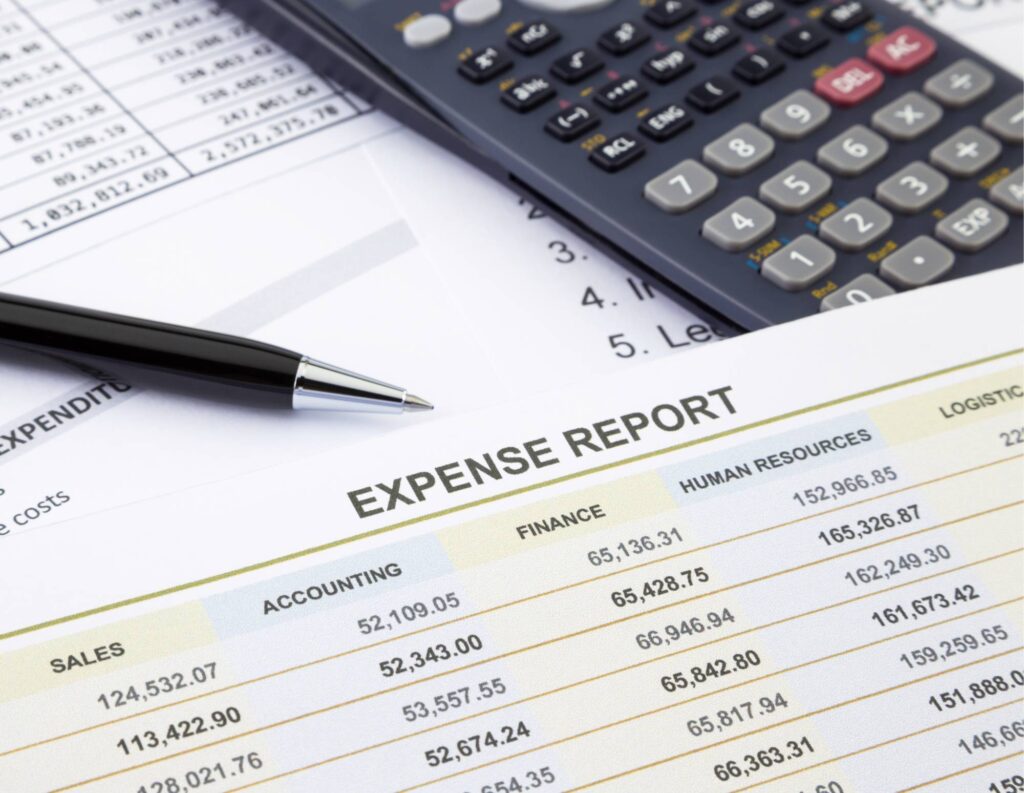Learning how to track business expenses can be crucial to manage your cash flow and return profits as an independent. In this article, HoneyBook Pro and bookkeeping expert Geily Romero walks you through setting up an efficient and effective no-fail business expense tracking system.

As an independent business owner, you always want to track business expenses for two crucial reasons. Tracking helps you maintain your cash flow to optimize your spending and reduce unnecessary costs. Tracking will also help you identify write-offs for operational expenses you can claim as tax deductions. You’ll end up paying less or getting back more at tax time.
If you’re struggling with tracking business expenses or need expert advice to set up an effective tracking system, this article is for you. Geily Romero, HoneyBook Pro, bookkeeper, and owner of Cutting Edge Financial Solutions, shares her most effective tips and advice for getting your tracking done right.
Jump to:
- Set up a separate business bank account
- Use an expense tracker
- Manage your receipts
- Categorize your expenses
- Align your expenses with profit to track cash flow
- Provide a seamless client experience and track expenses in one place
1. Set up a separate business bank account
First things first: If you’re just starting your business, you’ll want to set up a business bank account to manage your business finances separately from your personal finances. Here’s why:
- A separate business bank account looks professional and makes your business appear established and credible to your clients.
- A business account can sometimes be a necessity to get loans or additional funds approved by banks for running your business.
- Separating your business and personal accounts is more efficient for small business financial management. You’ll know exactly what you’re spending on your business and where. It also becomes easier to get on top of your taxes.
- Having a separate business bank account can help increase your money transaction limits. Personal accounts can be much more limited in terms of how much you can transact during a set period.
- Keeping business and personal accounts separate can help protect your personal assets if you ever have to deal with legal issues.
- A separate business account makes it easier to create accurate profit and loss statements for self-employed revenue.
Along with having a separate bank account, it’s also a good idea to assign a separate credit card for your business expenses to make your tracking easier, transparent, and more efficient.

Geily’s Pro Tip: Link your bank account to your bookkeeping software. This will help you keep your finances all in one place, making sure all your income is accounted for and no expenses are missed.
2. Use an expense tracker
If you’re not exactly shouting at the rooftops with excitement over doing your bookkeeping, you’re not alone. Most independents and small business owners loathe accounting. But consistently managing your cash is essential to creating a successful business for yourself.
The good news is, setting apart some time, ideally daily or at the very least monthly, to do your bookkeeping can make this task a lot easier to deal with.
Manually track your expenses with a spreadsheet or use something like an expense tracking app. You can use whichever method you find the most comfortable. Bear in mind that manual expense tracking can be prone to more errors, so if you decide to go down this route, spend time reviewing your accounting to make sure there are no mistakes.
Get our free expense tracking template
Not ready to onboard a new accounting software? No worries, download our expense tracking spreadsheet for free and start keeping tabs on your business spending.
Download the TrackerThere are many different expense-tracking apps available, and you can search for these online and refer to reviews to decide which ones to go for. Each independent will have their own preference as to which one they like the best. Don’t be afraid to opt for a few different ones to see what works best for you.

Geily’s Pro Tip: Have a system for tracking your expenses, whether that’s a manual spreadsheet or automated software, so you can not just see what’s going on with your expenses but also actively manage them.
3. Manage your receipts
Make it a habit to get or create receipts every time you make a purchase or sell a service so there’s no money unaccounted for, whether in or out. Plus, receipts are literally the best form of protection during annual audits.
Record every single receipt. You can opt to store your receipts manually or digitally. But it’s always a good idea to have a digital backup of your receipts because your paper receipts can fade over time or get damaged. If you can have your receipts emailed to you, that can make things more convenient.
You can use a receipt scanner to digitally scan your receipts or your smartphone camera and store the images on your computer. With accounting software, you can upload, assign, and track individual receipts.
When storing paper receipts, create folders or files based on the expense categories to organize them so you know where to look for them. Add additional notes wherever needed if your receipts don’t have enough detail on them about the specifics. Ideally, store the paper receipts for six years.

Geily’s Pro Tip: Save your receipts and upload them as soon as you get them, or set aside time to track them month to month. It helps you stay organized. Plus, you’re not leaving everything until much later or until the last minute, causing you to feel stressed and overwhelmed.
4. Categorize your expenses
Assign categories when you’re tracking expenses. Aside from simply making your business operations much more organized, it can also help you manage your budgeting. You’ll get visibility into how much you’re spending for each category and where you can cut costs.
Here’s a list of the most common categories you can use within your expense report:
- Rent and equipment
- Utilities, internet, and cell phone charges
- Office expenses and supplies
- Professional fees
- Marketing expenses
- Recurring software subscription fees
- Business insurance
- Loan and interest payments
- Continuing education or seminar attendance
- Business-related travel expenses
- Business-related vehicle expenses
- Charitable contributions
- Licenses and permits
- Client gifts
Make sure you’re paying your bills on time so you don’t incur additional fees or penalties. If you have a hard time keeping track of your bill due dates, use reminders or set up automatic monthly billing for your account.
Remember to track which expenses are tax-deductible so you can stay on top of it for tax time.

Geily’s Pro Tip: If you use bookkeeping software like QuickBooks, also make sure to assign a vendor to every expense as you categorize these. You’ll be able to pull an “Expenses by Vendor Summary Report” if you ever need to know how much you’ve paid a specific vendor rather than how much you’ve spent on a specific category.
5. Align your expenses with profit to track cash flow
Geily recommends you look at your income and expenses to see where you’re spending more.
“You may not have as much control over how much you make, but you have complete control over how much you spend.” – Geily Romero
Performing an expense audit helps you stay on top of your expenses. When performing an expense audit, set a goal to eliminate a certain amount of expenses, either by a specific dollar amount or by a percentage. Follow these three easy steps:
Step 1: Create a list of all expenses — monthly, quarterly, and yearly. If you have bookkeeping software like QuickBooks in place, download an “Expenses by Vendor Summary Report.”
Step 2: Let go of any unused expenses, like software, right away. Downgrade the software, find a more affordable option, or try a free one. Explore ways to consolidate a few expenses into a single software/subscription and save.
Step 3: Moving forward, set rules for allowing new expenses into the business. Routinely consider where you can cut expenses or increase your pricing to keep yourself in the green.
Geily also recommends you check your profit and loss report on a monthly basis. It’s a great way to ensure you’re maintaining a positive cash flow in your business.
When looking at your income and expenses on a monthly basis, make sure you’re bringing in enough income (top line) to cover all monthly expenses. If you are, your bottom line (net income) will be a positive number. Otherwise, it will be a negative number.
A positive number means you had a positive cash flow month. In other words, you had more cash flowing into the business than flowing out. A negative number means you had a negative cash flow month. You had more cash flowing out of the business than flowing in.

Geily’s Pro Tip: At the first sign of a negative cash flow month, consider where you can cut expenses or increase your pricing to keep yourself in the green. This will help you proactively control your expense management.
Provide a seamless client experience and track business expenses in one place
HoneyBook is a robust clientflow platform that helps you provide interactive online experiences that wow your clients while helping you manage your business without breaking a sweat.
More than 100,000 professionals use HoneyBook to easily create and send an online invoice to their clients, provide secure and fast payment options through online payment software, develop an easily-to-use ironclad online contract that can be signed online, and schedule and confirm bookings. Use the powerful automation features to schedule emails and follow-ups and stay on top of all your tasks. That’s not all.
HoneyBook also offers online payment processing and an expense report inside all members’ accounts. Members can easily track all their payments and expenses to get a 360-degree view of profit and loss. HoneyBook also has a QuickBooks integration so members can pull all their payment info from HoneyBook into QuickBooks.
Track payments and expenses in one place
An accurate view of cash in and cash out is crucial for managing your finances. Do it all in HoneyBoook’s all-in-one clientflow platform.
Start free trial


